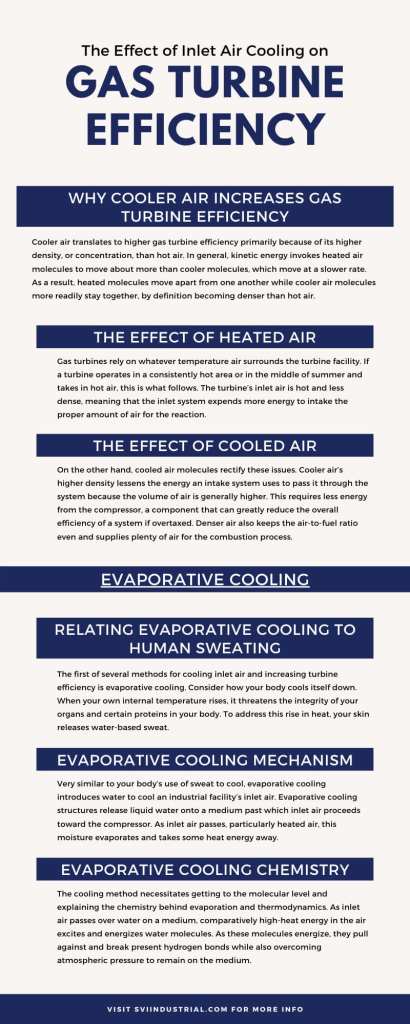
Written by Scott Schreeg | Technical
Gas turbines combust fuel and air to create significant heat. The resulting exhaust gases turn turbine rotor blades and create power. It’s vital to maintain precise conditions to ensure this reaction occurs consistently without unduly taxing the turbine system, including the compressor. Of the two necessary elements, fuel and air, this article will hone in on inlet air and how systems deliver it; namely, it will navigate the effect of inlet air cooling on gas turbine efficiency. Read on to learn more about how cooling affects efficiency and the various methods for inlet cooling.
Why Cooler Air Increases Gas Turbine Efficiency
Cooler air translates to higher gas turbine efficiency primarily because of its higher density, or concentration, than hot air. In general, kinetic energy invokes heated air molecules to move about more than cooler molecules, which move at a slower rate. As a result, heated molecules move apart from one another while cooler air molecules more readily stay together, by definition becoming denser than hot air. Higher volume intake air provides a ready and plentiful source of air for the combustion reaction.
The Effect of Heated Air
Gas turbines rely on whatever temperature air surrounds the turbine facility. If a turbine operates in a consistently hot area or in the middle of summer and takes in hot air, this is what follows. The turbine’s inlet air is hot and less dense, meaning that the inlet system expends more energy to intake the proper amount of air for the reaction. Also, the compressor’s job becomes more difficult because its job is to essentially artificially increase the density of the air, which requires more from the compressor when heated air molecules come in with a low density. Finally, less dense air cuts down on the total amount of fuel the turbine can combust, further reducing power-creation efficiency.
The Effect of Cooled Air
On the other hand, cooled air molecules rectify these issues. Cooler air’s higher density lessens the energy an intake system uses to pass it through the system because the volume of air is generally higher. This requires less energy from the compressor, a component that can greatly reduce the overall efficiency of a system if overtaxed. Denser air also keeps the air-to-fuel ratio even and supplies plenty of air for the combustion process.
Evaporative Cooling
Relating Evaporative Cooling to Human Sweating
The first of several methods for cooling inlet air and increasing turbine efficiency is evaporative cooling. Consider how your body cools itself down. When your own internal temperature rises, it threatens the integrity of your organs and certain proteins in your body. To address this rise in heat, your skin releases water-based sweat. This reduces heat by removing your body heat when the sweat evaporates or vaporizes into a gaseous form.
Evaporative Cooling Mechanism
Very similar to your body’s use of sweat to cool, evaporative cooling introduces water to cool an industrial facility’s inlet air. Evaporative cooling structures release liquid water onto a medium past which inlet air proceeds toward the compressor. As inlet air passes, particularly heated air, this moisture evaporates and takes some heat energy away.
Evaporative Cooling Chemistry
The cooling method necessitates getting to the molecular level and explaining the chemistry behind evaporation and thermodynamics. As inlet air passes over water on a medium, comparatively high-heat energy in the air excites and energizes water molecules. As these molecules energize, they pull against and break present hydrogen bonds while also overcoming atmospheric pressure to remain on the medium. These high-energy molecules vaporize and leave the medium because they are considerably higher energy than surrounding molecules. In the process, these vaporizing molecules take on heat energy from inlet air while also lowering the overall energy of remaining liquid water molecules. These remaining water molecules then take on energy from succeeding intake air and then evaporate as well. This progression ends up removing considerable energy from intake air, cooling the air while vaporizing water.
Wet-Bulb Temperature Limits
Evaporative cooling effectively reduces inlet air temperature, but there is a cap based on something called wet-bulb temperature. Essentially, wet-bulb temperature is—rather than the temperature measured from the air (what your home thermostat measures)—the temperature measured through a wet medium such as a cloth. This wet-bulb temperature is always lower than the dry-bulb temperature. Because evaporative cooling is not active refrigeration, the limit to how cooled inlet air can become is this wet-bulb temperature, which is higher than the relative dew point.
Chilling
While evaporative cooling has temperature limitations, chilling does not. Chilling can cool below the dew point because it doesn’t depend on evaporating moisture. The condensation that results is not the chilling mechanism—it’s a by-product of chilling that adds to the system’s overall auxiliary energy usage.
Chilling Mechanism
Chilling functions by passing inlet air through chilling coils. Heat energy transfers from the air into these coils. The efficiency of air chilling is highest before the condensation point, when heat energy transfers from the air molecules to the coils’ coolant. Once cooling passes the condensation point, the process “loses” cooling to the condensation process. While chillers can chill below the relative dew point, many facilities have controls in place to prevent system freezing. Overall, this chilling greatly cools inlet air and maximizes its density to ease the job of the compressor and regularly supply high-density air to make the combustion reaction viable.
How Environmental Conditions Affect Evaporative Cooling and Chilling
Clearly, the need for cooling mechanisms is greatest when intake air is hot. Ambient temperatures can change without much warning though, and these changes mean your cooling system needs to adjust as well. With evaporative cooling, higher air temperatures require more moisture to keep the heat-reduction process running smoothly. Also, fogging nozzles, which directly spray misted moisture into the system as a variant to evaporative cooling, depend on predictable residence times, or the time it takes for water to vaporize to protect the compressor from taking in moisture. When intake temperatures cool, these residence times may increase and risk exposing the compressor to moisture. As for chilling, high-humidity air more readily condenses into liquid water, requiring more energy from auxiliary processes, which brings down the overall efficiency of the turbine.
SVI Dynamics
If you have questions about the effect of inlet air cooling on gas turbine efficiency and how your specific system functions or could improve, the team at SVI Dynamic can help. We also offer solutions to other concerns with inlet air, including inlet silencers that mitigate noise created upon intake.

